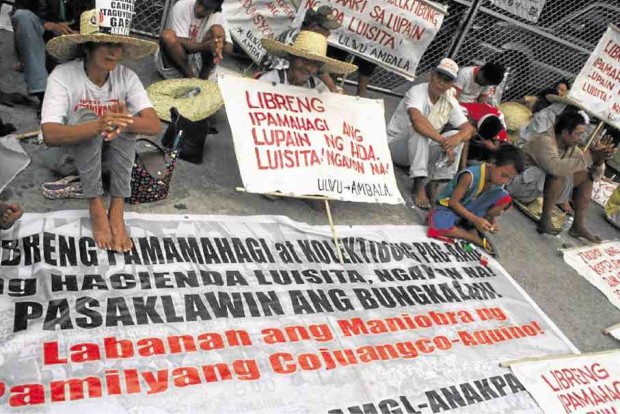
A group of farmworkers in Hacienda Luisita demands land although the Department of Agrarian Reform has distributed over 4,500 hectares to 6,229 tillers following an order from the Supreme Court in 2012. —E. I. REYMOND T. OREJAS/ CONTRIBUTOR
CITY OF SAN FERNANDO— Fear spread quickly in villages around Hacienda Luisita in Tarlac City on Sunday night when shots rang out at distributed agrarian lands now being fought over by farmworkers.
Agrarian Reform Secretary Rafael Mariano has been blamed for the tension in Mapalacsiao village near the Subic-Clark-Tarlac Expressway (SCTEx) because he has not yet resolved the dispute between farmworkers who have been tilling the disputed land since 2005 and farmers who have been awarded the land by the Department of Agrarian Reform.
“Mariano has been siding with members of the Alyansa ng Mga Manggagawang Bukid sa Asyenda Luisita,” Edison Diaz, barangay captain of Lourdes (formerly Texas) of Tarlac City, told the Inquirer by telephone on Monday.
Mariano chaired the Kilusang Magbubukid ng Pilipinas (KMP) before President Duterte appointed him agrarian reform secretary on July. Ambala is affiliated with the Unyon ng mga Manggagawa sa Agrikultura (UMA), a KMP organization.
Diaz said 50 farm workers in Lourdes have been holders of certificates of land ownership award (Cloa) for Mapalacsiao lands since 2014 but they have not been able to pay land fees to the Land Bank of the Philippines.
He said the Cloa holders tried to take their lands to grow crops but they were repulsed by Ambala members undertaking a land cultivation project called “Bungkalan.”
But Ambala member Augusto Quiambao, chair of Bungkalan, said the Cloa holders were being “used by the Cojuangco family to regain their control of the lands.”
Ambala rejected the agrarian reform program of the Department of Agrarian Reform during the term of former President Benigno Aquino III because he is a member of the Cojuangco clan. It also refused to recognize the Cloa because DAR drew lots by lottery (“tambiolo”) in determining the locations of farms awarded to land reform beneficiaries.
On Saturday, several Cloa holders tried to build huts or demolish structures occupied by Ambala members in Sitio Calumpang and Silangan after DAR employees had conducted an ocular inspection, Quiambao said.
But 111 Ambala members held their ground.
On Sunday night, Quiambao said they heard a series of shots. Diaz said he did not hear any.
On Monday, men from both camps were pacified by the police, according to Arnel Dizon, DAR regional director. The feuding farmers wielded bolos. “Nobody has been hurt so far,” Dizon said.
Around 50 policemen were sent to Hacienda Luisita to ease the tension.
The last violent incident there was on Nov. 16, 2004 when seven striking workers were killed following a riot when policemen and soldiers were ordered to retake the gate of the Luisita sugar mill.
Mariano did not take calls made by the Inquirer on Monday. An aide said he was on his way to a Cabinet meeting.
On July 1, Mariano ordered the Central Luzon and Tarlac offices of DAR to maintain the status quo over contested lots. “Barangay Captain Diaz and these Cloa holders are violating [Mariano’s] status quo order,” Quiambao said.
WHAT WENT BEFORE
July 5, 2011. The Supreme Court upholds the 2005 decision of the Presidential Agrarian Reform Committee to cancel the stocks distribution plan (sharing of stock than land as first form of agrarian reform in 1989 in Hacienda Luisita) and to distribute agricultural lands there. The SC affirmed its decision on Nov. 22, 2011 and April 24, 2012.
Dec. 3, 2012. FF Cruz begins surveys of HLI lands.
Feb. 27, 2013. DAR releases the final master list of farm workers-beneficiaries (FWBs).
May 6, 2013. Land Bank of the Philippines starts releasing to DAR the certificates of deposits to landowners up to June 2013.
May 20, 2013. At DAR’s request after land valuation and Land Bank release of certificates of deposit to DAR, Registry of Deeds starts issuing 51 titles transferring the ownership of HLI lands to the Philippine government until Sept. 5, 2013.
May 24, 2013. LRA starts approving survey plans.
July 18, 2013. DAR starts allocating 6,600 square meters to qualified FWBs by raffling off lots.
Oct. 3, 2013. DAR generates 6,516 certificates of land ownership award (Cloa) for 5,867 FWBs.
Oct. 9, 2013. DAR starts putting “mojon” (monuments or boundary stones) for each lot.
Jan. 28, 2014. DAR begins installing FWBs on their lots. At least 53 writs of installation have been issued to help qualified FWBs take possession of their lots from people who had been cultivating these before the SC order.
Feb. 28, 2014. The SC creates a panel to conduct a special audit on the books of HLI and Centenary Holdings Inc.
Aug. 26, 2014. DAR secretary grants petition of 46 qualified FWBs to claim lot allocation certificates and sign applications to purchase and farmers’ undertaking.
Jan. 14, 2015. 6,732 Cloa (97.79 percent of 6,744 Cloa) have been registered with registry of deeds. The total number of FWBs installed on their lots are 6,107.
Jan. 30, 2015. The DAR adjudication board denies the claim of HLI for additional compensation and interest, having already been paid P471.5 million.
Sources: 9th and 10th DAR compliance reports to SC dated Jan. 14, 2015 and April 14, 2015